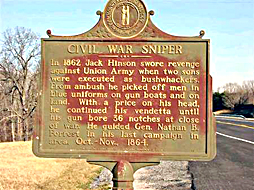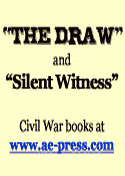|
‘Jack Hinson’s One-Man War’
McKenney persisted, pulled together
verifiably untold story of Civil War
In between strokes and 15 years of research, Col. Tom McKenney stayed on course and pulled together an untold story of the Civil War.
His 2009 book about Civil War sharpshooter Jack Hinson – “Jack Hinson’s One-Man War” - is amazing in that it’s about McKenney’s dogged determination as much as it concerns the Kentucky-Tennessee farmer who terrorized the Union Army for more than three years.
It all began in 1965 when McKenney, a retired Marine Corps veteran of Korea and Vietnam, ran across a Kentucky historical marker in Trigg County in the Land Between the Lakes area. The marker noted that Hinson, a Confederate sniper, had avenged the 1862 Civil War death of his sons by the Union Army and had continued his vendetta against the Federals until the end of the war. McKenney was intrigued by the account and never forgot it, although he would not find time to pursue the story until the 1990s.
Not much was known about the story of Jack Hinson other than the 65 words on the marker. So, McKenney, a Lexington native who now lives in Mississippi, began to travel though the area, scour libraries and public records, find family members and record their thoughts and memories. He suffered a slight stroke, but, during his rehabilitation, took time to continue his research and found Hinson’s custom-make rifle. Three years later, another stroke occurred, but McKenney continued his quest and, by 2004, gave the project top priority.
“Altogether, it took about 15 years,” he acknowledged.
“Jack Hinson was an amazing man. One of the more interesting things about him was his neutrality as a peacemaker before the murder and mutilation of his sons and the relentless killing machine he became after that.”
Hinson, McKenney discovered, wanted no part of the conflict and even had Union Gen. U.S. Grant visit in his home before his sons’ tragic deaths. He noted that Jack was “a typical man of the South and of his time, but he didn’t want to see the nation divided, and he opposed the war.”
But the increasing Federal occupation kept the war on the area’s doorstep, making neutrality nearly impossible. Ill treatment of families became more commonplace and guerrilla units retaliated, often causing the Union Army to take out its frustration on innocent parties.
On a bright and cold autumn morning, two Hinson brothers, George and John, were in the woods hunting. A patrol of the Fifth Iowa Cavalry discovered them, with rifles in hand, and assumed they were Confederate guerrillas – bushwackers – who had been ambushing their men. George and John were arrested and, despite their protests of innocence, were shot and killed. The soldiers beheaded the corpses and rode to the Hinson homestead where the heads of George and John were placed on the posts of the front yard gate.
Jack Hinson, McKenney points out, slowly and deliberately developed a plan of vengeance and realized he needed a special weapon to carry out his one-man war. He would need a .50-caliber weapon for long-range accuracy with a long and very heavy octagonal barrel and a caplock mechanism with a full stock.
Hinson said goodbye to his family and lived in the wilderness as he enacted his revenge. By the end of the war, he had recorded 36 notches on his weapon, but, in reality, had killed more than 100 Union soldiers.
Although the Union Army made an all-out effort, it never was able to catch Hinson. “Captain Jack,” as he was known, died in 1847 from natural causes, at the age of 67. However, the author points out, Hinson’s vendetta cost him at least six children, his farm, businesses and life as he had known it before the war.
McKenney noted in a recent interview that the Jack Hinson story also includes at least three important life lessons.
“It takes two to make peace, but only one to make a fight,” he said. “A brother offended is harder to be won than a strong city, and vengeance has a high price.”
|











